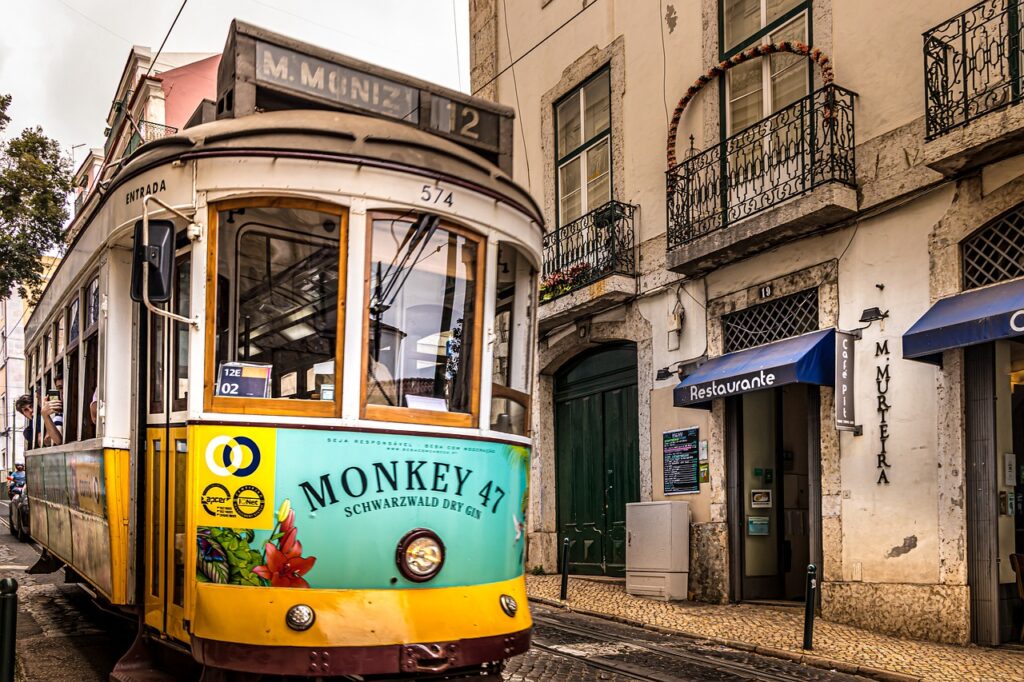General tips
When/where to go
Best time to visit: Spring (March-May) and Fall (September-October) are nice times to get less crowds but still pleasant, warm weather. Peak tourist season tends to be in Summer, especially July-August.
Where to go:
- Lisbon: The heart of Portugal, great food, cool vibes
- Porto: Centered around river Duoro, romantic, colorful picturesque neighborhoods, port wine
- Duoro Valley: Vineyards, wine country, relaxing
- Lagos: Coastal town, sandstone cliffs, water activities
- Azores: Epically beautiful volcanic islands, outdoor adventures, seaside towns, but hard to get to.
Getting Around
Porto and Lisbon are both great for walking, but prepare for some hills and old cobblestone roads. Wear comfortable walking shoes and watch where you step.
If you need a ride, consider jumping on the trams, a tuktuk or rent a GoCar (which also come with a self-guided audiotour). Ubers were cheap and readily available as well. To go from city to city, the train or a bus are your best options.
Some parts of Porto have free city wifi. Check to see if it’s available.
We could not find many public bathrooms in Porto, so try to prophylactic pee whenever you sit down to eat! The few bathrooms we did find (such as in the metro stations) usually required 0.20€, so keep some loose change on you!
Some places may be closed on Sundays and Mondays. Google had pretty accurate hours for most places but not all.
Language
Language: The primary language in Portugal is Portuguese, however it is very different from Brazilian Portuguese. Brazilians may run into some difficulty (even if they are fluent) due to the differences in pronunciation. Most younger people will know a little bit of English, and you can often ask for an English menu.
Here are some basic Portuguese phrases that may be useful:
- Ola (oh-LAH): Hello
- Bom dia (bohm JEEah): Good Morning
- Boa tarde (BOHah TAHRjee): Good Afternoon
- Boa noite (BOHah NOYchee): Good Evening
- Bom (bohm): Good
- Muito bom (mooEEtoo bohm): Very good
- Obrigada (ohbreeGAHdah) if female, Obrigado (ohbreeGAHdoh) if male: Thank you
- Onde fica * (ohnJEE FEEca): Where is *?
- Quanto custa (KWANtoo KUSHtah): How much?
Food/Money
Money: The Euro is used throughout Portugal. At the time of our travelling $1.00 = €0.85. You will get the best exchange rates by pulling money from ATMs rather than using most currency exchanges.
Tipping: It is not expected that you tip, but if you get exceptional service 10% is appreciated!
Foods to Try:
- Bacalhau: salty cod fish, comes in a 100 different ways of preparation.
- Bolinho de bacalhau: fried salted cod and cheese pastry. Our favorite was from Casa Portuguesa do Pastel de Bacalhau (this is the only item they make!)
- Pastel de Nata: egg custard pastry which is great with coffee. Each restaurant prepares their own version as well. Go to Manteigaria to try our favorite.
- Tartes de amendoa: almond pastry found in almost every bakery. Also excellent with coffee.
- Bolo rei: a Christmas fruitcake that you will only find at some bakeries. If you see it, try it. Was delicious!
- Brigaderos: more Brazilian, but also found in Portugal- delicious condensed milk sweets rolled into little balls. Try chocolate, grape, coconut.
- Fransecinha: Portuguese layered sandwhich with ham, sausage, cheese covered in melted cheese and creamy sauce. A regular dish here. Vegetarian and vegan versions can be found. Its okay.
- Prego– beef sandwhich with garlic and sauteed onions. Another regular dish here. Didn’t try.
- Caldo verde: a Portuguese potato soup which is rich and creamy. Great as an appetizer or snack!
- Tremoços: you will see the locals snacking on these yellow beans everywhere. Ask for a side of these wherever you go. They go great with a beer or cold drink and can be eaten with skins on or off.
- Azeitonas: Get a side of olives everywhere you go. The same conditions needed to make good wine also make excellent olives and they really are exceptional here.
- Port wine: birthplace of Port wine. You think you don’t like it, but you don’t even know. Make sure you try all the varieties including ruby, tawny, white and rosé. All of the wineries are located in Gaia, across the River Duoro from Porto.
- Porto tonico: a popular night out drink…port wine mixed with with tonic water.
- Super Bock: the Bud Light of Portugal. Popular beer, light and refreshing. Don’t pay more than 2€ for one!
Health/Safety
Water: The tap water is generally considered safe to drink! We drank tap water during our stay and had no issues.
Safety: Portugal is very safe and has even ranked as one of the safest countries for solo female travelers! Obviously still exercise caution and use your common sense, but we never felt in danger throughout our month living here.
COVID-19
As of Summer 2021, you need a negative PCR (within 72 hours of your flight time) or a negative antigen test (within 48 hours of your flight time) to enter Portugal from the United States.
You will also need a negative antigen or PCR (within 3 days of boarding your flight) to return to the United States. These requirements change frequently, so make sure you check each countries guidelines before booking travel.
You can obtain COVID testing at Lisbon airport, however make sure to arrive several hours early to ensure you have your results before your flight time.
We were able to obtain same-day antigen testing in Lisbon through SafeCheck-in. Many pharmacies also offer COVID testing, but are usually closed on Sundays so plan accordingly!
map:






